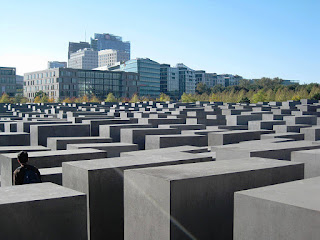BERLIN, GERMANY
It took me just one day to realize
that Berlin could very well be the capital of Europe. The sprawling city is centrally located
throughout the continent and is the most influential of the 20th
century. Oh wait, that was Hitler’s
idea. Nevermind.

The city felt so revolutionary. The horrid history left by Hitler was still
imbedded in the soul of the city. I
visited his bunker (now a parking lot) and spent a good amount of time at the
Topography of Terror, which brought you through Berlin from 1920-1989. The chronological story line was
fantastic. There stories and photographs
from the Holocaust and WW2 were overwhelming.
Did you know that Hitler was chosen as Time Magazine’s Man of the Year
in 1938? I couldn’t believe that Hitler
hosted the Olympics in Berlin in 1936!
The Nuremberg laws were already in place and he had stripped Jews of
their German citizenship. In preparation
of the games, the city removed signs from the city parks that read, ‘No Jews
allowed on the grass” and only those of the Aryan race were allowed to compete
for Germany. Hitler was implementing the
foundation for his final solution right under everyone’s noses! That really stuck with me.
The Holocaust museum whose real
name is The Memorial to the Murdered Jews of Europe was also influential. The city held a contest in 1996 to decide how
to appropriately pay tribute to the 6 million Jews that were murdered in
WW2. Can you imagine how difficult that
task would be? It took them three
contests to finally find an adequate representation. The American artist, Peter Eisenmann proposed
that the museum be underground and the area above be covered with 2,711 black
slabs arranged in a grid pattern on a sloping field. It was very smart and very solemn. In the
sunlight, shadows casted a black and white contrast. The slabs resembled the barracks of a
concentration camp and served as a labyrinth- it was chilling the way people
appeared and disappeared through the rows.
In drizzling rain, they had a gray appearance that made them look more
like tombstones and it was pretty depressing.
I was surprised with how many stupid tourists were climbing all over the
slabs and even playing hide-and-seek amongst the labyrinth.


Let’s move onto happier subjects
like the Cold War. Geez! What a relative term. I visited the three areas of the city where
the wall still exists. There was one
mural on the side of a building that showed an idealistic socialism and then a
large photograph from the 1960s that represented the realistic socialism. The Soviets constructed the wall and
barricades practically overnight on August 13, 1961.
The Brandenburg Gate that had once
served as a glorious gateway between east and west, was a barricade covered in
barbed wire during the 60s. Families
were torn apart by the wall between East and West Berlin and over 200 people
lost their lives trying to escape their life in captivity under the
Soviets. There were so many walls,
barricades, barbed wire, and booby traps (not to mention the infamous death
strip where Soviet soldiers could shoot anyone who tried to flee
westward). It’s amazing that there was
even one person who was brave (and desperate) enough to even try.
 |
| Brandenberg Gate in 1960s |
 |
| Original Berlin Wall |
 |
| Checkpoint Charlie |
 |
| You Are Now Leaving The American Sector |
 |
| Standing in between former wall dividing East and West Berlin |
I enjoyed my walk along the East
Side Gallery where artists around the world created murals surrounding the
significance of the wall. It was
impossible to choose a favorite. It definitely felt like a city of
artists! There was graffiti everywhere-
the kind that beautifies a city, not destroys it. It still felt so revolutionary. I spent a lot of time at Checkpoint Charlie,
which is famous for the Soviet/American tank standoff in 1961. Even though it felt a little bit like
Disneyworld with its recreation, I liked how they had the ominous picture of
the Soviet soldier always keeping a watch on the West and the American soldier
always keeping an eye on the East. I’m
not sure if that was the original sign that read ‘You are now leaving the
American sector’. I had conversations
with local and shop owners that were very moving. Just imagine if you woke up
tomorrow and there was a wall between your parents and you. So sad.
 |
| East Side Gallery |
 |
| East Side Gallery |
Another great thing about Berlin is
that I could go back in 2 years and it would look very different. This place is an urban planner’s dream! After heavy bombing throughout WW2, the city
was in constant need of repair. They
didn’t have much money so the repairs were done cheaply and are under a
constant state of construction. They
aren’t afraid to spend money on their architecture. They had many squares and plazas since
everything was so spread out. And since
they were divided into two cities for over 40 years, they have two sets of
everything- parks, museums, arenas, opera houses, court houses, etc. What an impressive city!!
 |
| Lustgarten |
 |
| Sunset in Berlin |
 |
Found a friend with some fashion sense along the way!
|
FOODS I TRIED: Mezzo mix cola, half boiled eggs, pretzel, kebabs (Amazing!), lots of beer














No comments:
Post a Comment